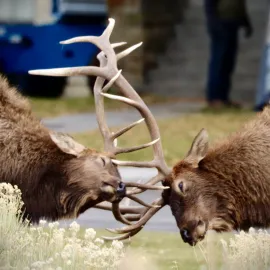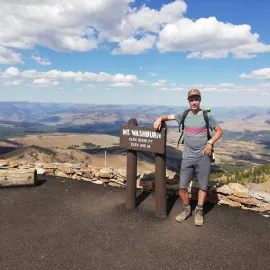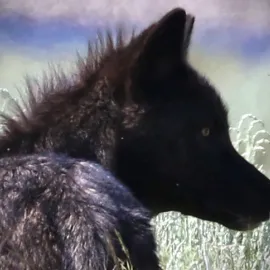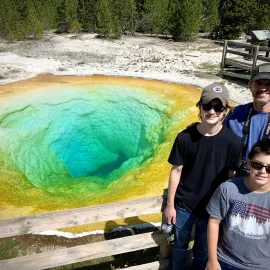Signs of Spring in Yellowstone National Park
As most of North America is warming up with the Spring Solstice, Yellowstone remains a wintery wonderland. Areas of the park are still covered in crazy amounts of snow with early morning temperatures dipping well below freezing. Most of the park is inaccessible to visitors, leaving the Lamar Valley one of the only visitable areas. Spring in Yellowstone is a time of excitement, relief, and anticipation. We all get excited when the interior of the park is open for exploration, relieved warmer weather is soon upon us. We eagerly anticipate spring wildlife watching in Yellowstone!

The Opening of the Yellowstone Road
Roads opening in Yellowstone is a sure sign of spring. Interior roads open around April 15th. Visitors are allowed to travel deeper into the park and see geysers and geology. Amazing sights like Old Faithful and the park's Grand Canyon are open for business! The road between Mammoth Hot Springs to West Yellowstone, and West Yellowstone to Old Faithful are the first to be cleared for travelers. The park’s roads are opened in phases with all the travelways open by Memorial Day. Before visiting Yellowstone always confirm the road openings from the NPS. (https://www.nps.gov/yell/planyourvisit/parkroads.htm).
BOOK A SPRING TOUR IN YELLOWSTONE
Spring Birds Migrate Back to Yellowstone
Birds are always an indication of spring in Yellowstone. Many of the park’s seasonal, winged residents start to reappear. Sandhill cranes (Grus canadensis) are often the first to show up. Sandhill Cranes winter in Texas, California, and as far south as Mexico. Sandhill Cranes are large terrestrial birds that have a distinct call which echoes all over YNP. Mountain bluebirds (Sialia currucoides) can be a promising note that summer is around the corner. The bright and vivid colors of the male bluebirds are hard to miss. Osprey (P. haliaetus), or the mighty “fish hawk,” will return to their old nests in the spring. Ospreys are seasonal residents of Yellowstone. They can be seen nesting along large bodies of water throughout the park. Yellowstone is an important fly-way and nesting ground for an incredible variety of waterfowl, song birds, and large birds of prey.
| Yellowstone Fun Fact...Young Sandhill cranes are called "colts". |
Bison Calves Start Exploring Yellowstone
Bison calves or “red dogs'' are arguably the most adorable newborns in Yellowstone. Bison babies are cute, spunky, and a highlight of spring. Cow bison start giving birth in April and the calving season can continue into mid-April or early May. The newborn bison are a reddish-orange color like an irish setter, hence the nickname red dogs. The calving process is a sight to behold. Calves are born and then are quickly up and moving with the herd. Bison calves can weigh between 30 to 70 lbs at birth. The calves are born with their eyes open and quickly come to their feet. It’s imperative for bison to be up and moving quickly. No time to waste in the wilds of Yellowstone!

| Did you know...The afterbirth of bison is a super rich food source in Yellowstone? Coyotes, ravens, black-billed magpies, and even ears will try to consume the post birth fluids. |
Black and Grizzly Bears Wake Up
Of course spring in Yellowstone means the awakening of bears from their winter slumber. As temps rise, bears start emerging from their dens. Typically, large male grizzly bears (Ursus arctos) awaken first, followed by sub-adults, moms with older cubs, and then grizzly sows with the new cubs. Cubs of the year are nicknamed ‘coys’. Bears will often look for winter-kill or old carcasses and early season vegetation. Look for spring grizzlies on the Blacktail Plateau, Slough Creek, and the Upper Hell Roaring region. Grizzlies wake up before their black bear (Ursus americanus) cousins. Areas around Tower Junction and between Mammoth and the Lamar Valley is great early season habitat for black bears. Prime black bear watching is usually between mid-May to early June.

Wildlife Returns to the Lamar Valley
The heart of the Lamar Valley is not always fruitful with wildlife during the winter months. The valley can often seem desolate with little animal activity. Spring brings a return of life to “America’s Serengeti”. Pronghorn, song birds, bison, osprey, bears, and other wildlife in Yellowstone start to return to the valley. Pronghorn migrate from their winter range near Gardiner, MT to the Lamar Valley. Bison follow the “green wave” and return to the northeast corner of the park. Ospreys start to reoccupy nests along the Lamar Canyon and river areas. Bears can be seen wandering the high areas in the Lamar Valley like Specimen Ridge and Mount Norris. The delightful call of the Western MeadowLark (Sturnella neglecta) can also be heard echoing through the area. Spring is a delight in the Lamar Valley.
Why Spring is the Best in Yellowstone!
- No Crowds - The park is quiet! March and April historically have the lowest monthly visitation rates. With no crowds and wilderness all around, Yellowstone is a special place in the spring.
- Wildlife Watching - Spring wildlife watching is amazing in Yellowstone. As snow still fills much of the landscape, animals are driven down to the low country. Spring is the best time to see bears in the park.
- The Scenery - Every photo you take looks like a postcard. The grass is green and snow covers the mountains of Yellowstone. It’s really hard to take a bad picture.
There is no bad time to visit Yellowstone. If you like seeing beautiful landscapes, small crowds, and tons of wildlife, spring is the season for you!
BOOK A TOUR IN YELLOWSTONE
Blog post by Chris Hondorf. Chris is owner and operator of Yellowstone Guidelines. For more information on booking a guided tour in Yellowstone, please call (406-599-2960) or email - tours@yellowstoneguidelines.com
















































